You can lose a project before it even starts.
Not because of price. Not because of quality. But because of time.
Construction bidding is brutal. Estimators are buried in spec books. Subs are overwhelmed with requests. Bids are delayed, scopes get missed, and opportunities slip away.
The problem isn’t in the skill; it is in the scale and time. That’s where AI enters the job site, and that's why AI in construction bidding is preferred even more.
Let’s break down how AI in construction bidding works, what’s changing in the industry, and why contractors embracing automation are winning faster, smarter, and more often.
Sie können ein Projekt verlieren, bevor es überhaupt beginnt.
Nicht wegen des Preises. Nicht wegen der Qualität. Aber wegen der Zeit.
Bauausschreibungen sind brutal. Die Schätzer sind in den technischen Büchern vergraben. Abonnenten sind mit Anfragen überhäuft. Angebote verzögern sich, Bereiche werden verpasst und Gelegenheiten verstreichen.
Das Problem liegt nicht in der Fähigkeit, sondern im Umfang und in der Zeit. Hier kommt KI auf die Baustelle, und aus diesem Grund wird KI bei Ausschreibungen für Baustellen noch mehr bevorzugt.
Lassen Sie uns aufschlüsseln, wie KI bei Bauausschreibungen funktioniert, was sich in der Branche ändert und warum Bauunternehmer, die sich für Automatisierung entscheiden, schneller, intelligenter und häufiger gewinnen.
Warum bremsen traditionelle Bauausschreibungen Sie aus?
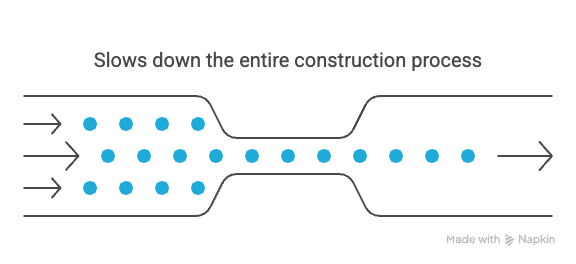
KI bei Bauausschreibungen löst ein Problem, das Schätzer seit Jahren plagt.
Die meisten Schätzer stecken nicht fest, weil es ihnen an Wissen mangelt. Sie stecken fest, weil sie in Dokumenten ertrinken.
Fachbücher erstrecken sich über Hunderte von Seiten. Jedes Angebot erfordert einen genauen Umfang, genaue Mengen und eine zuverlässige Deckung durch Subunternehmer. Aber hier ist, was normalerweise passiert:
- Teams verschwenden Stunden mit manuellen Starts
- Dateien sind auf gemeinsam genutzten Laufwerken verteilt
- Subunternehmer ignorieren Einladungen aufgrund eines schlechten Targetings
- Fristen verstreichen, Angebote bleiben uneingereicht und die Kosten steigen
Das Problem sind nicht die Fähigkeiten Ihres Teams. Es ist der langsame, manuelle Prozess.
KI-Tools für Bauausschreibungen beseitigen diese Reibung.. Sie erledigen die geschäftige Arbeit, schnell, präzise und ohne Abstriche, sodass sich Ihr Team auf das Wesentliche konzentrieren kann: intelligenter bieten und mehr gewinnen.
Vorher gegen Nachher: Was ändert sich bei AI Construction Bidding?
Herkömmliche Angebotsabläufe waren nicht auf Geschwindigkeit oder Klarheit ausgelegt. Sie sind unübersichtlich, manuell und schwer zu skalieren.
So sieht diese Verschiebung in der Praxis aus:
Der entscheidende Unterschied?
KI macht Rätselraten überflüssig, vermeidet manuelle Reibung und macht die Vorkonstruktion zu einem datengesteuerten Prozess, den Ihr Team tatsächlich genießen kann.
7 schnelle Erfolge durch den Einsatz von KI bei Bauausschreibungen
Vom Scannen umfangreicher Spezifikationsbücher bis hin zur Bereitstellung von Erkenntnissen von Subunternehmern in Echtzeit — KI-Tools optimieren jeden Schritt der Bauvorbereitung. Hier erfahren Sie, wie KI verschafft Auftragnehmern und Schätzern einen Wettbewerbsvorteil:
1. Scannt jede Seite und extrahiert, was wichtig ist
Bauunterlagen sind riesig, oft Hunderte von Seiten lang. Das manuelle Scannen nach relevanten Umfängen, Materialmengen oder Abbruchplänen ist langsam und fehleranfällig.
KI nimmt Ihnen die manuelle Arbeit ab. Sie scannt jede Seite Ihrer technischen Unterlagen, Zeichnungen und Plansätze. Dann markiert und extrahiert es wichtige Details, darunter:
- Beleuchtungsgrundrisse und Deckenabbaubereiche
- Abbruchbereiche und -phasen
- Mengenangaben für Armaturen, Rohre, Ventile und HLK-Komponenten
All diese Daten werden in einem durchsuchbaren digitalen Repositorium indexiert. Das bedeutet, dass Ihre Schätzer die benötigten Informationen sofort finden können, anstatt endlose PDFs zu durchsuchen. Keine verpassten Bereiche mehr. Keine vergrabenen Daten mehr.
2. KI verwandelt Ihren Planroom in einen durchsuchbaren, organisierten Hub
Wenn Subunternehmer nicht die richtigen Dateien finden, bieten sie nicht. So einfach ist das.
KI-Angebotsplattformen für Bauprojekte lösen dieses Problem, indem sie automatisches Organisieren Ihres Planraums:
- Die Dateien sind in übersichtliche Kategorien sortiert: Pläne, Spezifikationen, Fotos und Verschiedenes
- Jedes Dokument ist indexiert, sodass Seiten nach Stichwörtern durchsucht werden können
- Versionen werden synchronisiert, um veraltete Zeichnungen zu entfernen
- Links zum Teilen ermöglichen den Zugriff — kein Login oder Konto erforderlich
Dies bietet Subunternehmern ein besseres Erlebnis und Ihre Angebote erhalten Sie schneller zurück.
3. KI generiert ultragenaue Starts
Ungenaue Starts schaden Ihrem Geschäftsergebnis. Überschätzungen führen zu Materialverschwendung. Unterschätzungen führen zu kostspieligen Verzögerungen und überstürzten Nachbestellungen.
Mit der KI-gesteuerten Startautomatisierung werden Schätzungen datengestützt und hochpräzise. Diese Tools verwenden trainierte Algorithmen, die auf Tausenden von vergangenen Projekten basieren, um Folgendes zu berechnen:
- Genaue Mengen
- Materialklassifizierungen
- Arbeits- und Installationsschätzungen
Laut Altersquare können KI-gestützte Kostenprognosen Folgendes erreichen Genauigkeit von bis zu 97%. Dieses Maß an Präzision hilft Ihnen, zuverlässigere Angebote zu erstellen und Ihre Gewinnmargen zu schützen, bevor die Bauarbeiten überhaupt beginnen.
4. AI empfiehlt die richtigen Subunternehmer, nicht irgendjemanden!
Es ist nicht effektiv, Ihre gesamte Datenbank zu jedem Projekt einzuladen; es ist ineffizient.
KI-Angebotsplattformen für Bauunternehmen bringen intelligentes Matching von Subunternehmern ins Spiel. Sie analysieren und empfehlen Angebote auf der Grundlage von:
- Frühere Projektleistung
- Geografischer Standort und Servicegebiet
- Relevante Lizenzen, Zertifizierungen und Handelsspezialitäten
- CSI-Code-Ausrichtung
KI bereinigt auch Ihre Kontaktlisten, entfernt veraltete oder inaktive Anbieter und überprüft öffentliche Aufzeichnungen, sodass Sie nicht nach Nichterscheinen suchen müssen und Ihr Outreach-ROI verbessert wird.
5. KI sendet Angebotseinladungen, die Antworten erhalten
Generische Einladungen zum Kopieren und Einfügen erhalten keine Antworten. Subunternehmer werden täglich mit Anfragen überflutet, und die meisten werden ignoriert.
KI behebt dies mit intelligenter, personalisierter E-Mail-Kontaktaufnahme. Einladungen werden automatisch generiert und beinhalten:
- Name und Beruf des Subunternehmers
- Projektspezifische Informationen wie Umfang, Größe und Termine
- Ein klares Wertversprechen: Warum dieses Angebot für sie wichtig ist
- Folgeerinnerungen werden zu optimalen Zeiten geplant
Das Ergebnis? Personalisierte, KI-generierte Ausschreibungen erhöhen die Rücklaufquoten von Subunternehmern schrittweise.
6. KI verfolgt das Gebotsengagement in Echtzeit
Herkömmliche Ausschreibungssysteme bieten eine eingeschränkte Sichtbarkeit. Möglicherweise sehen Sie ein vages „Vielleicht“ oder „Angesehen“, aber das reicht nicht aus, um Maßnahmen zu ergreifen.
KI-Tools für Ausschreibungen im Bauwesen bieten Einblicke in das Engagement in Echtzeit, indem sie Folgendes zeigen:
- Wer hat Ihre Angebotseinladung geöffnet
- Welche Dokumente haben sie angesehen oder heruntergeladen?
- Wie lange haben sie damit verbracht, die Materialien zu überprüfen?
- Welche Maßnahmen haben sie danach ergriffen?
Mit diesen Daten können Sie Abonnenten mit hohem Interesse priorisieren, zeitnahe Follow-ups senden und Ihre Trefferquote verbessern, ohne es zu erraten.
7. KI sorgt für mehr Klarheit und reduziert das Risiko
Missverstandene Bereiche führen zu Änderungsaufträgen, Preisfehlern und verzögerten Entscheidungen.
KI-Tools für Ausschreibungen im Bauwesen gehen über die Extraktion hinaus; sie verknüpfe jeden Bereich zurück zu seinem ursprünglichen Kontext in den Dokumenten. Abonnenten können klicken und die Quellzeichnung oder Spezifikationslinie sehen, was ihnen volle Transparenz und Sicherheit bei der Preisgestaltung bietet.
Dies führt zu:
- Weniger Klarstellungen und RFI-E-Mails
- Weniger Änderungsaufträge während der Ausführung
- Bessere Angebotsvergleiche zwischen Anbietern
Generalunternehmer erhalten klarere Spielräume. Subunternehmer erleben weniger Überraschungen. Jeder gewinnt.
Deutlicher ROI von KI-Bauausschreibungen
Bei KI geht es bei Bauausschreibungen nicht nur um Geschwindigkeit, sondern auch darum, in jeder Phase des Vorbereitungsprozesses intelligenter zu arbeiten. Von der Überprüfung von Dokumenten bis hin zur Beauftragung von Subunternehmern verwandeln KI-Tools einen chaotischen, manuellen Arbeitsablauf in einen optimierten, skalierbaren Betrieb.
Lassen Sie uns noch einmal zusammenfassen:
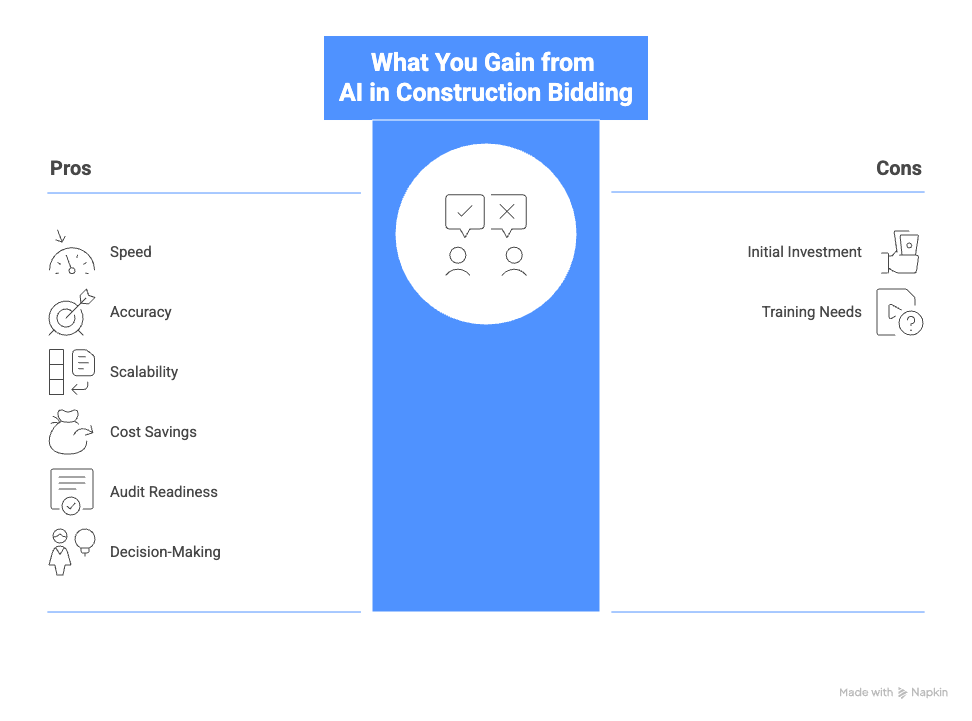
- Zeitersparnis
KI-Tools können die Schätzzeit um bis zu reduzieren 50%, sodass Schätzer schneller auf Angebotsmöglichkeiten reagieren können, ohne Abstriche bei der Genauigkeit machen zu müssen.
- Genauigkeit und reduzierter Materialabfall
KI-gestützte Starts können eine Genauigkeit von bis zu 97% erreichen, was Auftragnehmern hilft, Schätzfehler erheblich zu reduzieren. Das führt zu 5— 10% weniger Materialüberschreitungen, was die Kostenkontrolle und Rentabilität direkt verbessert.
- Effizienz des Arbeitsablaufs
KI vereinfacht die Dokumentenprüfung und indexiert automatisch Zeichnungen und Spezifikationen aus mehreren Disziplinen. Dadurch entfällt die Notwendigkeit, Hunderte von Seiten manuell zu durchsuchen, was die Zusammenarbeit verbessert und das Risiko beseitigt, an veralteten Versionen zu arbeiten.
- Höhere Erfolgsquoten bei Geboten
Auftragnehmer, die KI-gestützte Schätzungen und gezielte Angebotsstrategien verwenden, erhalten bis zu einer 20% Verbesserung der Gewinnraten. Präzise Vorschläge, schnellere Reaktionszeiten und eine bessere Abstimmung der Subunternehmer tragen direkt zu mehr Projekten bei, die ausgezeichnet wurden.
- Verbessertes Engagement von Subunternehmern
Anstatt generische Einladungen an eine ganze Liste von Subunternehmern zu senden, kann KI die richtigen Subunternehmer auf der Grundlage von Handel, Standort, Lizenzierung und Angebotshistorie den richtigen Projekten zuordnen. Personalisierte, relevante Einladungen führen zu höheren Öffnungs- und Rücklaufquoten.
- Sichtbarkeit von Geboten in Echtzeit
Mit KI-Tools, die das E-Mail-Engagement verfolgen, erhalten Sie einen Einblick, welche Subunternehmer Einladungen geöffnet, Dokumente angesehen oder mit der Bearbeitung von Angeboten begonnen haben. Dies hilft Teams dabei, Folgemaßnahmen zu priorisieren und den Überblick über den Angebotszyklus zu behalten, ohne mehrere Systeme zu benötigen.
KI ersetzt nicht die menschliche Intuition. Es gibt Ihnen Zeit, damit Sie sie besser nutzen können.
Wer profitiert am meisten von KI bei Bauausschreibungen?
KI bei Bauausschreibungen ist nicht nur für technisch versierte oder große Unternehmen geeignet. Es hilft allen, die am Ausschreibungsverfahren beteiligt sind, schneller zu arbeiten, Fehler zu reduzieren und vom Schätzer bis zum Abnehmer den Überblick zu behalten.
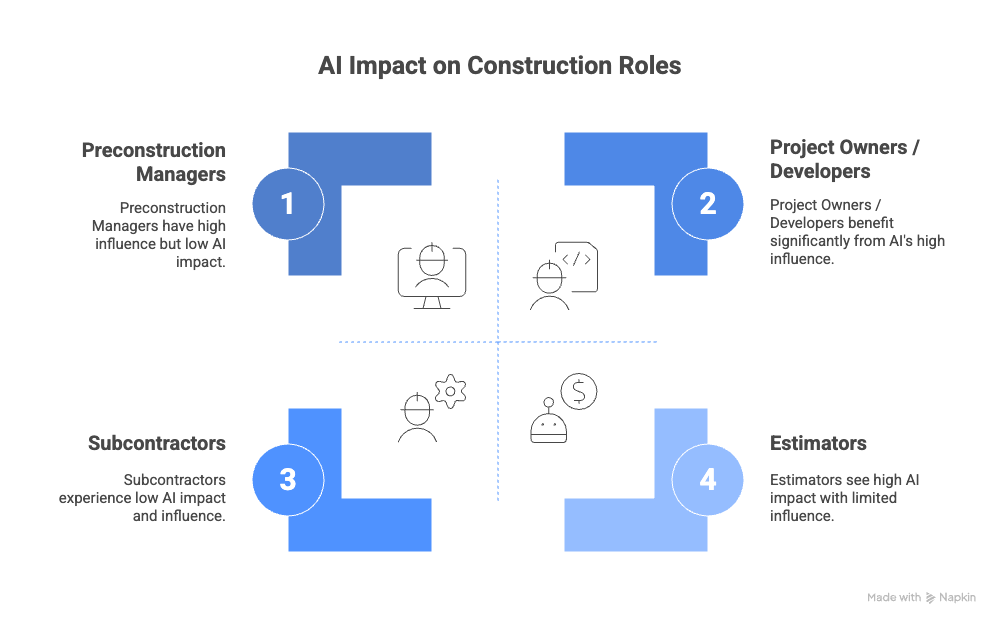
Schätzer
- Automatisieren Sie Starts und Extraktion des Umfangs
- Verbringen Sie mehr Zeit mit der Überprüfung von Risiko, Preisstrategie und Value Engineering
Generalunternehmer
- Reichen Sie mehr Angebote ein, ohne den Arbeitsaufwand zu erhöhen
- Verbessern Sie die Reichweite der Abonnenten und die Wettbewerbsfähigkeit Ihrer Angebote
Subunternehmer
- Erhalten Sie personalisierte Einladungen für relevante Bereiche
- Schneller Zugriff auf Tarife, schnellere Preise und weniger Verwirrung
Leiter der Bauvorbereitung
- Verschaffen Sie sich einen Überblick über jedes laufende Angebot
- Bessere Koordination zwischen Teams und Anbietern
Projekteigentümer//Entwickler
- Reduzieren Sie Nacharbeiten und Änderungsaufträge
- Verbessern Sie die Projektzeitpläne und die Kostenvorhersehbarkeit
KI ist nicht nur ein technisches Upgrade, sie spart Zeit, erhöht die Genauigkeit und stärkt das Selbstvertrauen für alle Beteiligten.
Worauf sollte man bei einer KI-Angebotsplattform für Bauprojekte achten?
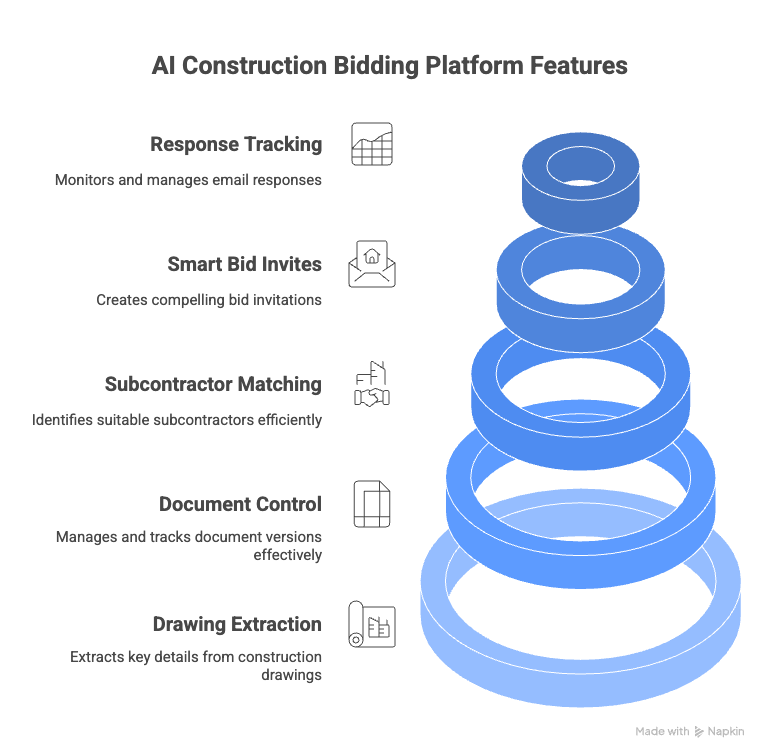
Sie müssen nicht Ihren gesamten Bieterprozess überarbeiten, um KI testen. Beginnen Sie mit einer Plattform, die Folgendes bietet:
Extraktion von Zeichnungen und Spezifikationen
Ihr KI-Tool sollte in der Lage sein, komplette Plansätze, einschließlich Architektur-, Mechanik-, Elektro- und Sanitärzeichnungen, zu scannen und relevante Bereiche, Materialien und Mengen automatisch zu extrahieren. Sie müssen nicht mehr durch Hunderte von Seiten blättern, nur um eine einzelne Zeile zu bestätigen.
Interpretiert KI technische Diagramme korrekt? Jetzt anschauen
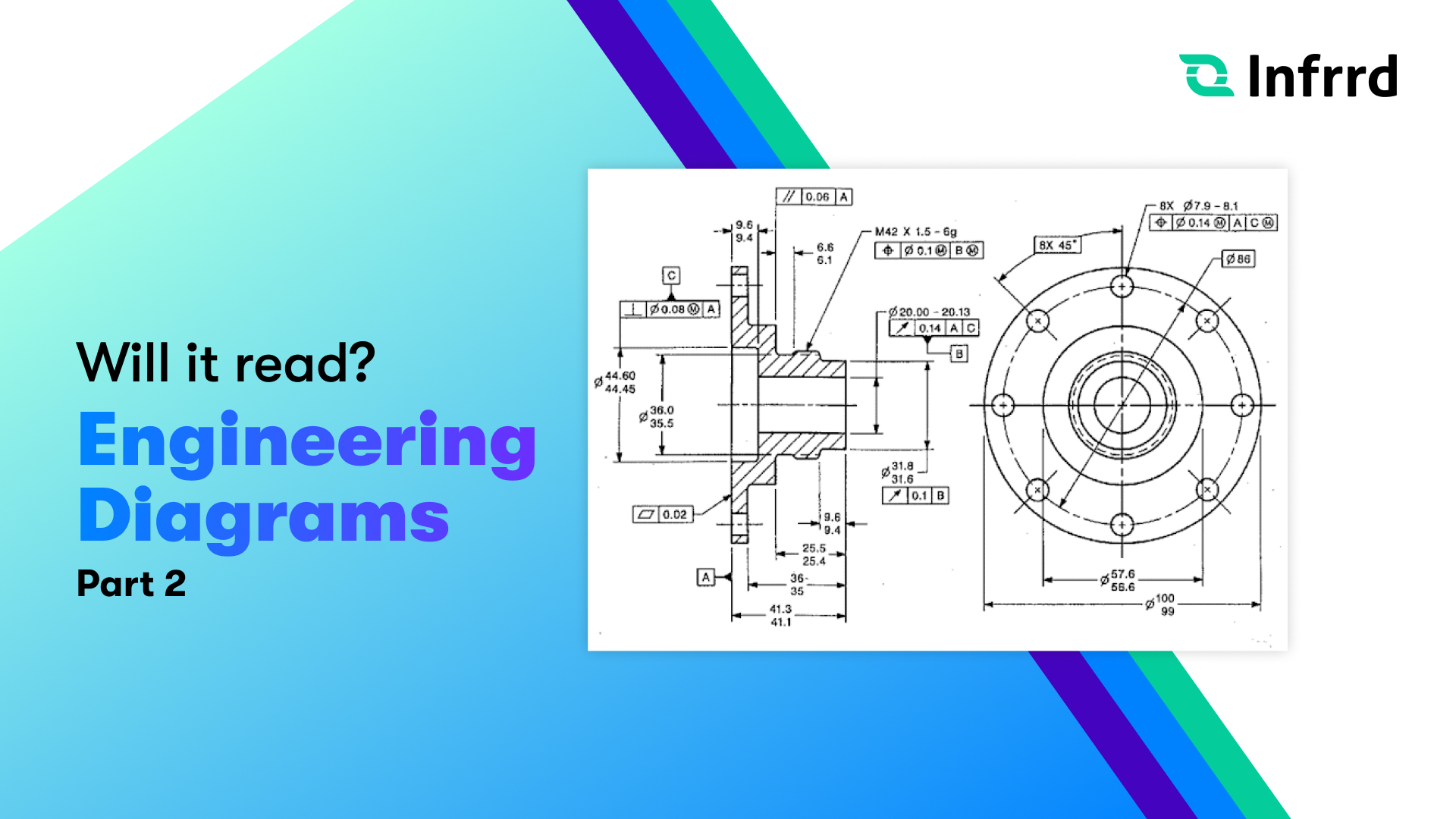
Indizierung und Versionskontrolle von Dokumenten
Da Pläne aus mehreren Quellen eingehen, ist es eine Herausforderung, alles zu organisieren.
Die Plattform sollte jede Datei automatisch indexieren, die Blätter korrekt beschriften und sicherstellen, dass alle mit der neuesten Version arbeiten, damit Abonnenten keine Zeit mit veralteten Zeichnungen verschwenden.
Subunternehmer-Matching, das Ihnen Stunden spart
Hör auf, deine gesamte Unterliste einzuladen und zu hoffen, dass die richtigen antworten.
KI kann Abonnenten anhand von Handel, Standort, Lizenzierung, vergangener Gebotsverlauf und mehr dem Job zuordnen. So können Sie Einladungen versenden, die relevant sind und die Wahrscheinlichkeit einer Konversion erhöhen.
Smart Bid lädt ein, die geöffnet werden
Eine gut geschriebene, klar zielgerichtete Angebotseinladung wird wahrgenommen.
Die Plattform sollte Einladungen mit projektspezifischen Details, Handelsausrichtung und Fristen personalisieren und dann automatisch weiterverfolgen. Dieses eine Upgrade kann die Anzahl der Abonnenten, die tatsächlich antworten, erheblich verbessern.
E-Mail-basiertes Antworttracking
Sichtbarkeit ist während des Angebotszyklus alles.
Sie sollten sehen können, wer Ihre Einladung geöffnet hat, was sie sich angesehen haben und ob sie aktiv an einem Gebot arbeiten, ohne sich in ein separates System einloggen zu müssen.
Je mehr Sie wissen, desto besser können Sie Folgemaßnahmen priorisieren und den Kreis schließen.
Einige Tools funktionieren in Ihrem Posteingang. Andere bieten vollständige Gebotsplattformen. Wählen Sie eine, die sich leicht integrieren lässt und die Dinge einfach hält.
Moderne Bauausschreibungsplattformen Integrieren Sie zunehmend umfassende Dokumenteninformationen, um wichtige Details aus Spezifikationen und Zeichnungen zu extrahieren, die Organisation des Planraums für einen einfacheren Zugriff auf Projektdateien zu optimieren und strukturierte Arbeitsabläufe zu ermöglichen, die die Koordination mit Subunternehmern vereinfachen und gleichzeitig den manuellen Aufwand und die Komplexität minimieren.
Häufig gestellte Fragen zu KI-Bauausschreibungen
Ersetzt das mein Schätzungsteam?
Nein. Es unterstützt sie. KI kümmert sich um die langweiligen Dinge, sodass sie sich auf das Wesentliche konzentrieren können, nämlich die Überprüfung von Risiken, Preisstrategien und Beziehungen.
Ist es schwer zu lernen?
Die besten Tools benötigen kein langes Onboarding. Wenn Sie E-Mails senden können, können Sie AI-Bidding verwenden.
Funktioniert es für meinen Projekttyp?
Die meisten KI-Tools unterstützen heute den gewerblichen Bau, wobei immer mehr in den privaten und öffentlichen Sektor ausgeweitet werden.
Letztes Wort
KI kommt nicht, sie ist schon da.
Wenn Ihr Team immer noch mit Tabellen, technischen Daten und Listen nicht reagierender Subunternehmer jongliert, ist es vielleicht an der Zeit für einen besseren Weg.
Für KI-Bauausschreibungen ist keine vollständige Prozessüberholung erforderlich. Es verändert die Art und Weise, wie Sie mit den sich wiederholenden, zeitaufwändigen Teilen umgehen, sodass Sie sich auf die Entscheidungen konzentrieren können, mit denen Projekte gewonnen werden.
Plattformen helfen Auftragnehmern und Schätzern:
- Reichen Sie mehr Gebote ein, ohne an Genauigkeit einzubüßen
- Verschaffen Sie sich einen Überblick über die Angebotsaktivitäten und das Engagement von Subunternehmern
- Automatisieren Sie langwierige Schritte wie die Extraktion des Umfangs und die Kontaktaufnahme mit Unterabteilungen
Die Arbeit gehört immer noch dir. Aber die erste Schicht? Lass die KI das regeln.
Häufig gestellte Fragen
Software zur Überprüfung und Prüfung von Hypotheken ist ein Sammelbegriff für Tools zur Automatisierung und Rationalisierung des Prozesses der Kreditbewertung. Es hilft Finanzinstituten dabei, die Qualität, die Einhaltung der Vorschriften und das Risiko von Krediten zu beurteilen, indem sie Kreditdaten, Dokumente und Kreditnehmerinformationen analysiert. Diese Software stellt sicher, dass Kredite den regulatorischen Standards entsprechen, reduziert das Fehlerrisiko und beschleunigt den Überprüfungsprozess, wodurch er effizienter und genauer wird.
IDP verarbeitet effizient sowohl strukturierte als auch unstrukturierte Daten, sodass Unternehmen relevante Informationen aus verschiedenen Dokumenttypen nahtlos extrahieren können.
KI verwendet Mustererkennung und Natural Language Processing (NLP), um Dokumente genauer zu klassifizieren, selbst bei unstrukturierten oder halbstrukturierten Daten.
IDP nutzt KI-gestützte Validierungstechniken, um sicherzustellen, dass die extrahierten Daten korrekt sind, wodurch menschliche Fehler reduziert und die allgemeine Datenqualität verbessert wird.
IDP (Intelligent Document Processing) verbessert die Audit-QC, indem es automatisch Daten aus Kreditakten und Dokumenten extrahiert und analysiert und so Genauigkeit, Konformität und Qualität gewährleistet. Es optimiert den Überprüfungsprozess, reduziert Fehler und stellt sicher, dass die gesamte Dokumentation den behördlichen Standards und Unternehmensrichtlinien entspricht, wodurch Audits effizienter und zuverlässiger werden.
Wählen Sie eine Software, die fortschrittliche Automatisierungstechnologie für effiziente Audits, leistungsstarke Compliance-Funktionen, anpassbare Audit-Trails und Berichte in Echtzeit bietet. Stellen Sie sicher, dass sie sich gut in Ihre vorhandenen Systeme integrieren lässt und Skalierbarkeit, zuverlässigen Kundensupport und positive Nutzerbewertungen bietet.







